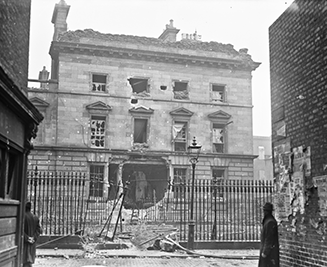THE CIVIL WAR BEGINS
Published in Issue 3 (May/June 2022), Volume 30By Joseph E.A. Connell Jr
At 3.40am on 28 June 1922, the anti-Treaty IRA in the Four Courts were given an ultimatum to surrender by troops of the Provisional Government (increasingly referred to as the ‘National Army’) under the command of Michael Collins. When they refused, firing commenced twenty minutes later—the Irish Civil War had begun.
Eighteen-pounder guns were ‘borrowed’ from the British Army and, under the command of Emmet Dalton, were located south of the river at the corners of Bridgefoot Street and Usher’s Quay, Winetavern Street and Merchant’s Quay, and along Hammond Lane on the north side. Single rounds were fired at fifteen-minute intervals and a total of 375 shells were fired before the garrison surrendered. The British did not trust the Irish with high-explosive shells and issued only shrapnel rounds, which were mostly ineffective against the stone walls of the building.
Eamon de Valera quickly described the members of the Four Courts garrison as the ‘best and bravest of our nation’ and enlisted in the IRA as an unranked soldier.
Twelve members of the IRA Executive were in the Four Courts when it was attacked. Liam Lynch and Liam Deasy had left the building shortly before; they were arrested but then released on the orders of Richard Mulcahy, who hoped that they would be a moderating influence. (Lynch went across to the Clarence Hotel on Wellington Quay. He was sleeping there when the attack commenced. He left to go to the south, but he and Deasy were captured again. They were taken for questioning by Eoin O’Duffy, who again let them go. They subsequently went to Kingsbridge Station and caught a train south with Séumas Robinson. From south-west Ireland, Lynch and Deasy became the leaders of the anti-Treaty forces during the Civil War.)
On 29 June, Ernie O’Malley took over command in the Four Courts. By that time the shelling had caused the Courts to catch fire. In addition, orders arrived from Oscar Traynor, IRA commander in Dublin, for the garrison to surrender, as he could not reach their position to help them. At 3.30pm on 30 June, O’Malley surrendered the Four Courts to Brigadier General Paddy Daly.

Above: The breach in the western wall of the PRO’s Records House from the direction of Church Street, along Hammond Lane, one of two through which National Army troops eventually entered the Four Courts complex on 30 June 1922. (NLI)
Several hours before the surrender, the garrison’s ‘headquarters block’ along Chancery Street, which had been used as an ammunition store by the garrison, was the centre of a huge explosion. The consequent fire spread to a munitions factory in the adjacent Public Records Office (PRO) and nearly 1,000 years of Irish state and religious archives were destroyed. Forty advancing National Army troops were badly injured. It was alleged by the National Army HQ that the anti-Treaty forces had deliberately booby-trapped the PRO to kill advancing National Army troops. Tim Healy, a government supporter, later alleged that the explosion was the result of land-mines laid before the surrender. A recent study by Michael Fewer (The Battle of the Four Courts (Head of Zeus, 2018) and HI 27.4, July/Aug. 2019, pp 44–7) concluded, however, that there was no evidence of deliberate detonation and that the explosion was caused by fires ignited by the shelling, which eventually spread to the PRO.
Joe Considine, Seán Cusack and Thomas Wall were killed in the bombardment. One hundred prisoners were taken and sent to Mountjoy Prison, among them Rory O’Connor, Liam Mellows, Joe McKelvey and Dick Barrett, later executed on 8 December 1922 in reprisal for the shooting dead of TD Seán Hales the day before. Ernie O’Malley was among a group who escaped on the way to Mountjoy.
It should be noted that the gun-carriage on which Michael Collins’s casket was later transported to Glasnevin Cemetery was one used in the bombardment of the Four Courts in June. The Provisional Government specially purchased four black artillery horses from the British to pull it to Glasnevin.
Joseph E.A. Connell Jr is the author of The Terror War: the uncomfortable realities of the Irish War of Independence (2021, Eastwood Books).
















